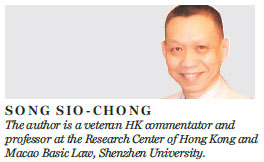'One Belt, One Road' a boon for HK
Updated: 2015-07-16 08:44
By Song Sio-chong(HK Edition)
|
|||||||
Song Sio-chong writes that the city can look forward to playing a significant role in the nation's big infrastructure plans - in finance, logistics, shipping and promotion
Chief Executive Leung Chun-ying visited Beijing for a specially convened meeting with State leaders on Monday. The agenda included "One Belt, One Road", enabling Hong Kong to further explore its roles in these massive ventures.
Pioneered by President Xi Jinping in 2013, "One Belt, One Road" comprises the Silk Road Economic Belt and the 21st Century Maritime Silk Road. The former aims to establish a cohesive economic belt across Central Asia, West Asia, the Middle East and Europe with high-speed railway works; the latter aims to link Southeast Asia, the Indian Ocean and Africa by various port works. Both infrastructure projects will enhance trade, cultural exchanges and economic development for countries along the belt and the "sea road".
This wide-ranging plan involves more than 60 countries with a total population of 4.4 billion, accounting for 63 percent of the global population. The aggregate economic value of those countries amounts to $21 trillion, representing around 29 percent of global gross domestic product. Both massive projects at current estimates will amount to $20 trillion.
Almost two years has elapsed since the announcement of the huge "One Belt, One Road" project, during which the central government has been formulating the blueprints. What opportunities can Hong Kong grasp? The city qualifies to serve in many aspects.
First, as an international financial hub and the largest RMB offshore center, Hong Kong may serve as the operations center for the Asian Infrastructure Investment Bank (AIIB), providing services such as RMB cross-border trade settlement and bond issuance to the world. Under the "One Belt, One Road" initiative, the RMB will certainly be used extensively to settle trades, payments and final accounting of individual projects, in order to reduce exchange rate risks. Hong Kong will play a significant role in helping the RMB in its march along the path of internationalization, gradually leading it to become the reserve currency.
As stated in Leung Chun-ying's speech at the Boao Forum for Asia Annual Conference 2015, the RMB trade settlement managed by Hong Kong banks in 2014 totaled 6.3 trillion yuan ($1.01 trillion), rising by 60 percent over the previous year. The issuance of RMB bonds in Hong Kong reached 200 billion yuan in 2014 - an increase of 69 percent from 2013. Hong Kong also hosts the world's largest offshore RMB liquidity of more than 1.1 trillion yuan as at the end of January 2014. These figures will only escalate to greater heights after the commencement of "One Belt, One Road" projects.
Second, Hong Kong may provide international logistics services as a strategic location, particularly for the 21st Century Maritime Silk Road. Geographically, Hong Kong is located at the pivot of the Maritime Silk Road, serving as the gateway connecting the Chinese mainland with Southeast Asia, and vice versa.
Hong Kong is the world's fourth-busiest container port. Its average annual container throughput has exceeded 23 million TEUs over the past 10 years. The Port of Hong Kong provides comprehensive liner shipping services, with about 350 services a week connecting to more than 500 destinations worldwide. It also has a world-leading International Trade Data System. Since a renowned free port is an indispensable logistics avenue within the "One Belt, One Road" framework, Hong Kong should soon become the world's busiest container port once again - just as it was from 1999 to 2004.
Third, there can be no debate that China has some of the world's greatest engineering talent, the best standards and code of practices, and the best designs, construction practices and infrastructure in the world. Both the "Belt" and "Road" involve substantial construction and engineering services such as feasibility studies, site investigations, design, construction, supervision, testing and commissioning, to be furnished by Chinese engineers and other professionals. If such capability is not sufficiently recognized among the 60 countries involved in "One Belt, One Road", the execution of the projects will certainly be less effective. Therefore, Hong Kong may have a role to play in promoting the nation's expertise.
Finally, many of the 60 countries along the "Belt" and "Road" have established consular and other official or semi-official mission in Hong Kong. Thus, the Ministry of Foreign Affairs may contact these consular officers to determine the attitudes of their countries toward various projects. Information so acquired can serve as a guide for the estimation of project risks, while public relations and marketing work may start early.
Massive global projects normally face criticism and diplomatic pressure, and "One Belt, One Road" is no exception. Objections may come from various countries. Some Western media may try to stigmatize the Chinese-initiated project as "new colonialism", or even as a "new threat". Hong Kong, with its mature information systems and internationally influential media, may serve as a counter-balance to this. Given its image, press freedom and high standards of English, Hong Kong can become an ancillary spokesman for the nation.
In short, Hong Kong may serve as the financial center, international logistics centre, free port, and promoter of the nation's engineering talent and work for "One Belt, One Road". Indeed, Hong Kong can considerably strengthen the country's soft power under "One Country Two Systems".

(HK Edition 07/16/2015 page9)